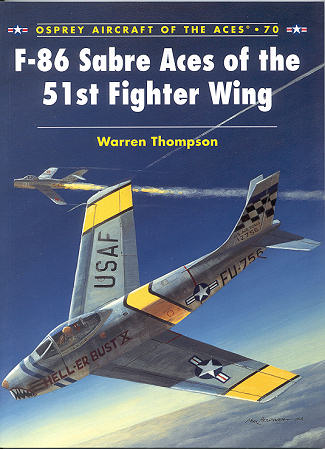 Many of us
have a fascination with the Korean War. It was one that many of our fathers
fought in if they missed WWII and many fought in both. It was also the first
'jet war', pinning the USAF's first capable jets against those of the West's new
adversary, the Soviet Union. Fortunately for the West, the Soviets chose only to
use Korea as a training ground for Soviet and East German fighter units, for had
they decided to really get involved in the war, things may not have turned out
as they did.
Many of us
have a fascination with the Korean War. It was one that many of our fathers
fought in if they missed WWII and many fought in both. It was also the first
'jet war', pinning the USAF's first capable jets against those of the West's new
adversary, the Soviet Union. Fortunately for the West, the Soviets chose only to
use Korea as a training ground for Soviet and East German fighter units, for had
they decided to really get involved in the war, things may not have turned out
as they did.
Thankfully, each unit seemed to stay about six weeks. Long
enough to show the new guys in the unit what it was like to fly some combat and
give the old hands (or 'honchos') an opportunity to mix it up with the USAF in
the last few days and perhaps add to their WWII scores. As the MiG-15bis was
basically a better aircraft in nearly all respects aside from diving speed than
the F-86, when flown by a masterful pilot, it was able to give many American
pilots a very nervous time in a dog-fight.
The 51st FW was called into service in Korea after the 4th FW
had been in country for a while. Initially entering the country in mid 1951, a
base cadre of the wing was developed from pilots pulled from other stateside
units, including its commanding officer, Francis Gabreski. He brought many
others from the 56 FW and along with the new F-86E soon got down to the business
of getting the wing ready for combat. Not an easy task as they were short on
parts, maintenance crews and manuals, pilots and just about everything else,
including planes.
Eventually the wing got into action and though the first few
months were rather bare of success, it wasn't long before they were in the thick
of things. Along with the 4th FW, their task was to patrol along the Yalu River
to prevent communist aircraft from interfering with fighter-bomber sorties in
North Korea. Not an easy task when the enemy's planes had an altitude and
climbing advantage. Often the MiGs would parade about at 45-50,000 feet while
the Sabres were down at 40,000 feet itching for a fight.
Later the F-86F that was introduced in 1953 would help to
even out the altitude advantage of the MiG's but not the firepower or climbing
or dog-fighting abilities. That would be buffered by the greater training and
experience of the American crews.
As you'd expect, the book has a superb historical section and
quite a few of the 'I was there' stories that so many of us love to read. Some
of them funny, some of them scary and apparently all of them true. It was the
51st wing that eventually had the highest scoring US jet ace of all time, Joseph
McConnell who bagged 16 aircraft during his tour of duty and for whom McConnell
AFB in Kansas is named.
Warren Thompson does a superlative job of telling the story,
accompanied by a number of period photos and great selection of profiles. I
sorely miss Warren's 'Osprey Color' series on Korean War units and wish he was
able to continue that, but until that happens, you can become immersed in this
book as was I. It is one that I know you'll like and I highly recommend it to
you.
August 2006
For more on the complete line of Osprey books,
visit www.ospreypublishing.com. In the US, it is
Osprey Direct at 44-02 23rd St, Suite 219, Long Island City, NY 11101., where you can
get a catalogue of available books.
If you would like your product reviewed fairly and quickly by a
site that has nearly 325,000 visitors a month, please contact
me or see other details in the Note to
Contributors.
 Many of us
have a fascination with the Korean War. It was one that many of our fathers
fought in if they missed WWII and many fought in both. It was also the first
'jet war', pinning the USAF's first capable jets against those of the West's new
adversary, the Soviet Union. Fortunately for the West, the Soviets chose only to
use Korea as a training ground for Soviet and East German fighter units, for had
they decided to really get involved in the war, things may not have turned out
as they did.
Many of us
have a fascination with the Korean War. It was one that many of our fathers
fought in if they missed WWII and many fought in both. It was also the first
'jet war', pinning the USAF's first capable jets against those of the West's new
adversary, the Soviet Union. Fortunately for the West, the Soviets chose only to
use Korea as a training ground for Soviet and East German fighter units, for had
they decided to really get involved in the war, things may not have turned out
as they did.